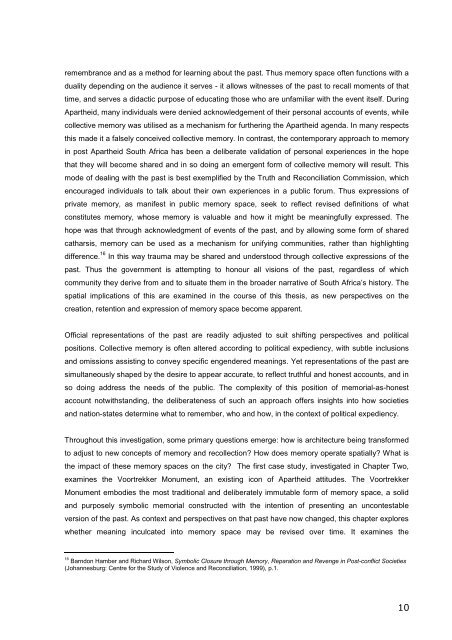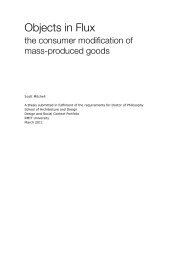Making Memory Space: Recollection and Reconciliation in Post ...
Making Memory Space: Recollection and Reconciliation in Post ...
Making Memory Space: Recollection and Reconciliation in Post ...
You also want an ePaper? Increase the reach of your titles
YUMPU automatically turns print PDFs into web optimized ePapers that Google loves.
emembrance <strong>and</strong> as a method for learn<strong>in</strong>g about the past. Thus memory space often functions with a<br />
duality depend<strong>in</strong>g on the audience it serves - it allows witnesses of the past to recall moments of that<br />
time, <strong>and</strong> serves a didactic purpose of educat<strong>in</strong>g those who are unfamiliar with the event itself. Dur<strong>in</strong>g<br />
Apartheid, many <strong>in</strong>dividuals were denied acknowledgement of their personal accounts of events, while<br />
collective memory was utilised as a mechanism for further<strong>in</strong>g the Apartheid agenda. In many respects<br />
this made it a falsely conceived collective memory. In contrast, the contemporary approach to memory<br />
<strong>in</strong> post Apartheid South Africa has been a deliberate validation of personal experiences <strong>in</strong> the hope<br />
that they will become shared <strong>and</strong> <strong>in</strong> so do<strong>in</strong>g an emergent form of collective memory will result. This<br />
mode of deal<strong>in</strong>g with the past is best exemplified by the Truth <strong>and</strong> <strong>Reconciliation</strong> Commission, which<br />
encouraged <strong>in</strong>dividuals to talk about their own experiences <strong>in</strong> a public forum. Thus expressions of<br />
private memory, as manifest <strong>in</strong> public memory space, seek to reflect revised def<strong>in</strong>itions of what<br />
constitutes memory, whose memory is valuable <strong>and</strong> how it might be mean<strong>in</strong>gfully expressed. The<br />
hope was that through acknowledgment of events of the past, <strong>and</strong> by allow<strong>in</strong>g some form of shared<br />
catharsis, memory can be used as a mechanism for unify<strong>in</strong>g communities, rather than highlight<strong>in</strong>g<br />
difference. 16 In this way trauma may be shared <strong>and</strong> understood through collective expressions of the<br />
past. Thus the government is attempt<strong>in</strong>g to honour all visions of the past, regardless of which<br />
community they derive from <strong>and</strong> to situate them <strong>in</strong> the broader narrative of South Africa’s history. The<br />
spatial implications of this are exam<strong>in</strong>ed <strong>in</strong> the course of this thesis, as new perspectives on the<br />
creation, retention <strong>and</strong> expression of memory space become apparent.<br />
Official representations of the past are readily adjusted to suit shift<strong>in</strong>g perspectives <strong>and</strong> political<br />
positions. Collective memory is often altered accord<strong>in</strong>g to political expediency, with subtle <strong>in</strong>clusions<br />
<strong>and</strong> omissions assist<strong>in</strong>g to convey specific engendered mean<strong>in</strong>gs. Yet representations of the past are<br />
simultaneously shaped by the desire to appear accurate, to reflect truthful <strong>and</strong> honest accounts, <strong>and</strong> <strong>in</strong><br />
so do<strong>in</strong>g address the needs of the public. The complexity of this position of memorial-as-honest<br />
account notwithst<strong>and</strong><strong>in</strong>g, the deliberateness of such an approach offers <strong>in</strong>sights <strong>in</strong>to how societies<br />
<strong>and</strong> nation-states determ<strong>in</strong>e what to remember, who <strong>and</strong> how, <strong>in</strong> the context of political expediency.<br />
Throughout this <strong>in</strong>vestigation, some primary questions emerge: how is architecture be<strong>in</strong>g transformed<br />
to adjust to new concepts of memory <strong>and</strong> recollection? How does memory operate spatially? What is<br />
the impact of these memory spaces on the city? The first case study, <strong>in</strong>vestigated <strong>in</strong> Chapter Two,<br />
exam<strong>in</strong>es the Voortrekker Monument, an exist<strong>in</strong>g icon of Apartheid attitudes. The Voortrekker<br />
Monument embodies the most traditional <strong>and</strong> deliberately immutable form of memory space, a solid<br />
<strong>and</strong> purposely symbolic memorial constructed with the <strong>in</strong>tention of present<strong>in</strong>g an uncontestable<br />
version of the past. As context <strong>and</strong> perspectives on that past have now changed, this chapter explores<br />
whether mean<strong>in</strong>g <strong>in</strong>culcated <strong>in</strong>to memory space may be revised over time. It exam<strong>in</strong>es the<br />
16 Barndon Hamber <strong>and</strong> Richard Wilson, Symbolic Closure through <strong>Memory</strong>, Reparation <strong>and</strong> Revenge <strong>in</strong> <strong>Post</strong>-conflict Societies<br />
(Johannesburg: Centre for the Study of Violence <strong>and</strong> <strong>Reconciliation</strong>, 1999), p.1.<br />
10
















